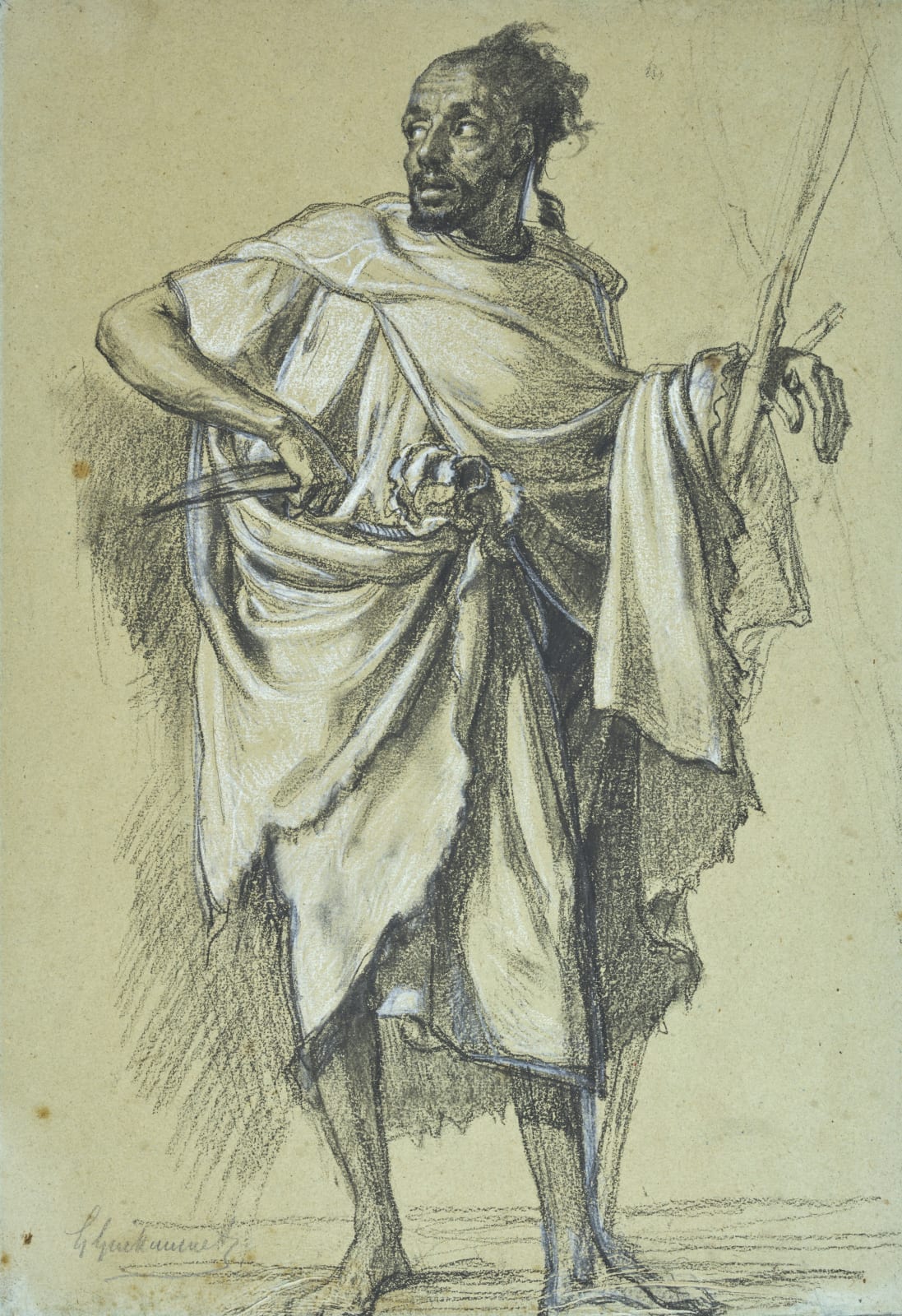 Gustave Guillaumet - The Arab Market on the Tocria Plain - Musée des Beaux-Arts de Lille
Gustave Guillaumet - The Arab Market on the Tocria Plain - Musée des Beaux-Arts de Lille
 Gustave Guillaumet - The Arab Butcher - detail of The Arab Market on the Tocria Plain. Musée des Beaux-Arts de Lille
Gustave Guillaumet - The Arab Butcher - detail of The Arab Market on the Tocria Plain. Musée des Beaux-Arts de Lille
Gustave Guillaumet French School, 1840-1887
46 x 32.1 cm
Further images
This intensely expressive figure is a preparatory study for "Arab Market on the Tocria Plain", a painting exhibited at the 1865 Salon and now in the Musée des Beaux-Arts in Lille.
1. Gustave Guillaumet, a "Saharan" painter with a passion for Algeria
Gustave Guillaumet was born into a family of industrialists; this affluence allowed him to be financially independent throughout his life, which was quite rare in the artistic circles of the time. A student of François Edouard Picot (1786-1868) and Félix-Joseph Barrias (1822-1907) at the Ecole des Beaux-Arts in Paris, Gustave Guillaumet exhibited his paintings at the Salon from 1861 to 1880. He differed from most other Orientalist painters by his deep knowledge of the Orient, and more specifically of Algeria, which he discovered in 1862. He left for Italy after failing at the Prix de Rome in 1861, but the bad weather on his way encouraged him to take a boat to Algeria in Marseille.
Despite the malaria he caught there, which forced him to spend three months at the military hospital in Biskra, he returned enthusiastic about this country, where he went back a dozen times. He was the only painter to visit the extreme south of Algeria at that time, and particularly the Laghouat region, on the edge of the Sahara, which he discovered in 1877.
As François Mouquin wrote in 2018 in the catalogue of the exhibition devoted to Guillaumet: "his painting was not a simple genre painting. It was the portrait of a culture, that of Algeria, whose light he was able to master marvellously. He translated those customs, those traditional activities and the patriarchal life of this thousand-year-old civilisation, in a way which was better than any other could have done and equivalent to that of an ethnologist."
Guillaumet died at the age of forty-seven on 14 March 1887 in his studio located at 5 Cité Pigalle. He was buried in the Montmartre cemetery, where his grave has been decorated with a sculpture by Louis Barrias (the brother of his teacher at the Beaux-Arts) depicting a seated young Algerian woman.
2. The Arab market on the Tocria plain
This vast painting (211 x 342 cm) was exhibited at the 1865 Salon, alongside Evening in the Sahara, south of Bou-Saâda, another Saharan genre scene depicting a caravan stopover (whereabouts unknown). Placed under a zenithal sun, this Market was presented in opposition to a twilight view.
This market scene evokes an essential aspect of life for the semi-nomadic populations of southern Algeria. Its location probably refers to Ain Tokria, an archaeological site in the commune of Khemisti on the Sersou plateau (some 100 km as the crow flies from the coast, between Algiers and Oran). Still rather inhospitable at the time, this region of extensive farming and cattle-raising was a major strategic zone between the Tell and the Saharan Atlas. The motif was probably also inspired by the large market held a little further east, in the Boghar region (Ksar el Boukhari), which was an important trading place where shepherds and farmers were purchasing cereals, dates, wool and sheep.
The frieze composition featuring hieratic figures camped in a desert landscape is typical of the artist's work. In this arid environment, crushed by the meridian light, the artist develops a restricted chromatic range - the off-white of the burnous, the ochres of the earth, the azure of the sky - enhanced by a few touches of vivid color.
These two paintings, which represent a "pacified" vision of the "natives"[1] of the Southern Territories, were well received at the 1865 Salon (one was bought by the Beaux-Arts department, the other by the Emperor with his civil list) and exhibited at the 1867 Universal Exhibition. Guillaumet took up the same subject again in 1877[2], radically renewing the composition with the addition of female figures, absent from our first painting.
The study we are presenting is part of a rather large corpus of drawings and painted studies documenting not only the Sersou landscape, but also every figure, every gesture, and every group in the painting, as in this study of Young Bedouin (for the figure in the foreground, in the center of the composition).
The Arab butcher, on the left of the composition, is much smaller in the painting than in our study, demonstrating the artist's care in preparing the smallest details of his composition.
The painted depiction of our butcher differs little from the preparatory study we present, except in the position of the tripod used to display the pieces of meat on which he nonchalantly rests his left wrist, a tripod which is located behind his legs in this preparatory study. Moreover, in our drawing, the blade of the knife gripped in his right hand, combined with the intensity of his gaze, lend him a terrifying quality, as if he were an oriental version of a bloodthirsty Bluebeard, which contrasts with the debonair physiognomy of the young man depicted in the painting.
3. Framing
Our drawing is presented in an extraordinary frame: probably 19th-century Italian and possibly Piedmontese, it is decorated with cubic marquetry reminiscent of Andalusian craftmanship inspired by Mudejar art.
Main bibliographical references :
Gustave Guillaumet – Tableaux Algériens - 1888 - Librairie Plon - Paris
(collective work produced for the 2018 exhibition) L'Algérie de Gustave Guillaumet - 2018 Gourcuff Gradenigo
[1] Gustave Guillaumet's Algeria - 2018 Gourcuff Gradenigo page 141
[2] Market in Kabylia - Rouen - Musée des Beaux-Arts








